Traditional Chinese medicine Master XIONG Jibo’s medication experience in treating arthralgia syndrome through data mining
DENG Wenxing,ZHANG Jidong,ZHANG Wenn,HE Qinghu,e*
a. College of Integrated Traditional Chinese and Western Medicine,Hunan University of Chinese Medicine,Changsha,Hunan 410208,China
b. Inheritance Studio of Traditional Chinese Medicine Master XIONG Jibo,the First Hospital of Hunan University of Chinese Medicine,Changsha,Hunan 410007,China
c. Technology Center of Zhuhai Shanggu Xinglin Health Industry Investment Management Co.,Ltd.,Zhuhai,Guangdong 519031,China
d. Department of Traditional Chinese Medicine,Huafa New Town Community Health Service Center,Xiangzhou District,Zhuhai,Guangdong 519000,China
e. Department of Rehabilitation and Healthcare,Hunan University of Medicine,Huaihua,Hunan 418000,China
ABSTRACT Objective This study aimed to examine and propagate the medication experience and group formula of traditional Chinese medicine (TCM) Master XIONG Jibo in diagnosing and treating arthralgia syndrome (AS) through data mining.Methods Data of outpatient cases of Professor XIONG Jibo were collected from January 1,2014 to December 31,2018,along with cases recorded in A Real Famous Traditional Chinese Medicine Doctor: XIONG Jibo's Clinical Medical Record 1, which was published in December 2019. The five variables collected from the patients’ data were TCM diagnostic information,TCM and western medicine diagnoses,syndrome,treatment,and prescription. A database was established for the collected data with Excel. Using the Python environment,a customized modified natural language processing (NLP) model for the diagnosis and treatment of AS by Professor XIONG Jibo was established to preprocess the data and to analyze the word cloud. Frequency analysis,association rule analysis,cluster analysis,and visual analysis of AS cases were performed based on the Traditional Chinese Medicine Inheritance Computing Platform (V3.0) and RStudio (V4.0.3).Results A total of 610 medical records of Professor XIONG Jibo were collected from the case database. A total of 103 medical records were included after data screening criteria,which comprised 187 times (45 kinds) of prescriptions and 1 506 times (125 kinds) of Chinese herbs.The main related meridians were the liver,spleen,and kidney meridians. The properties of Chinese herbs used most were mainly warm,flat,and cold,while the flavors of herbs were mainly bitter,pungent,and sweet. The main patterns of AS included the damp heat,phlegm stasis,and neck arthralgia. The most commonly used herbs for AS were Chuanniuxi (Cyathulae Radix),Huangbo (Phellodendri Chinensis Cortex),Cangzhu (Atractylodis Rhizoma),Qinjiao (Gentianae Macrophyllae Radix),Gancao (Glycyrrhizae Radix et Rhizoma),Huangqi(Astragali Radix),and Chuanxiong (Chuanxiong Rhizoma). The most common effect of the herbs was “promoting blood circulation and removing blood stasis”,followed by “supplementing deficiency (Qi supplementing,blood supplementing,and Yang supplementing)”,and “dispelling wind and dampness”. The data were analyzed with the support ≥ 15% and confidence = 100%,and after de-duplication,five second-order association rules,39 third-order association rules,39 fourth-order association rules,and two fifth-order association rules were identified. The top-ranking association rules of each were “Cangzhu (Atractylodis Rhizoma) →Huangbo (Phellodendri Chinensis Cortex)” “Cangzhu (Atractylodis Rhizoma) + Chuanniuxi(Cyathulae Radix) → Huangbo (Phellodendri Chinensis Cortex)” “Chuanniuxi (Cyathulae Radix) + Danggui (Angelicae Sinensis Radix) + Gancao (Glycyrrhizae Radix et Rhizoma) →Qinjiao (Gentianae Macrophyllae Radix)” and “Chuanniuxi (Cyathulae Radix) + Danggui(Angelicae Sinensis Radix) + Gancao (Glycyrrhizae Radix et Rhizoma) + Huangbo (Phellodendri Chinensis Cortex) → Qinjiao (Gentianae Macrophyllae Radix)”,respectively. Five clusters were obtained using cluster analysis of the top 30 herbs. The herbs were mainly drying dampness,supplementing Qi,and promoting blood circulation. The main prescriptions of AS were Ermiao San (二妙散),Gegen Jianghuang San (葛根姜黄散),and Huangqi Chongteng Yin (黄芪虫藤饮). The herbs of core prescription included Cangzhu (Atractylodis Rhizoma),Chuanniuxi (Cyathulae Radix),Gancao (Glycyrrhizae Radix et Rhizoma),Huangbo(Phellodendri Chinensis Cortex),Mugua (Chaenomelis Fructus),Qinjiao (Gentianae Macrophyllae Radix),Danggui (Angelicae Sinensis Radix),and Yiyiren (Coicis Semen).Conclusion Clearing heat and dampness,relieving collaterals and pain,and invigorating Qi and blood are the most commonly used therapies for the treatment of AS by Professor XIONG Jibo. Additionally,customized NLP model could improve the efficiency of data mining in TCM.
Keywords Traditional Chinese medicine Master XIONG Jibo Arthralgia syndrome Data mining Natural language processing (NLP) Medication experience Association rules
1 Introduction
Arthralgia syndrome (AS) was first recorded in theYellow Emperor's Inner Classic(Huang Di Nei Jing,《黄帝内经》).Plain Questions · on Arthralgia(Su Wen · Bi Lun,《素问·痹论》) reports that “Wind,cold,and dampness are mixed and combined to form AS”[1]. AS is mainly characterized by muscle,bone,and joint pain,as well as heaviness,insensitivity,joint swelling,and burning,accompanied by limb numbness or swelling[2]. In western medicine,gout,rheumatoid arthritis,ankylosing spondylitis,and osteoarthritis are all categorized as AS,and they can be treated according to the syndrome differentiation of AS[3]. Great advances have been made in the development of disease-modifying anti-rheumatic drugs(DMARDs) which are anti-inflammatory and prevent further joint injury[4]. The available DMARDs are classified into: (i) conventional synthetic DMARDs,such as methotrexate,hydroxychloroquine,and sulfadiazine; (ii) targeted synthetic DMARDs,such as Pan-JAK- and Jak1/2-inhibitors; and (iii) biological DMARDs,such as tumor necrosis factor (TNF)-αinhibitors,TNF-receptor (R) inhibitors,Interleukin-6 (IL-6) inhibitors,IL-6R inhibitors,B cell consumption antibodies,and costimulatory molecule inhibitors. Although DMARDs have repeatedly demonstrated the potential to significantly improve disease symptoms and prevent disease progression in patients with AS,these drugs can lead to adverse liver and kidney reactions,hypertension,and gastric ulcer[5]. Patients who are diagnosed with chronic pain,combined with rheumatoid arthritis and those whose disease is not easily cured using modern treatment regimens,are likely to seek traditional drug therapies. Approximately 60% -90% of patients with arthritis have used traditional medicines[6]. Traditional Chinese medicine (TCM) has advantages in the treatment of autoimmune diseases,and its multi-component,multi-channel,and multi-target integration effect can control the progress of the long-term disease[7]. TCM is commonly used as the adjuvant therapy for the treatment of knee osteoarthritis[8],ankylosing spondylitis[9],and arthralgia syndrome[10],with good curative effects.
The experience of some famous TCM doctors suggest that insect drugs[11],Chuanwu (Aconiti Radix),Chuanniuxi (Cyathulae Radix),Fangfeng (Saposhnikoviae Radix),Chuanxiong (Chuanxiong Rhizoma),etc. have good curative effects on AS[12]. Professor XIONG Jibo,a TCM Master,has profound attainments in Qihuang's skills,and is good at treating AS. He attaches great importance to syndrome differentiation and treatment in the clinic,guided by the theory of TCM,and has accumulated extensive clinical experience[13]. Professor XIONG Jibo believes that AS should be distinguished from flaccid syndrome(Weizheng). Flaccid syndrome is mainly characterized by limb flaccidity,weakness,muscle thinness,and no joint pain[14]. AS can be divided into seven syndrome types[15],including moving arthralgia (diffused pain),pain arthralgia (localized pain),and damp arthralgia (limb pain and heavy numbness),etc. To properly differentiate AS,wind cold dampness (joint pain with no redness,swelling,and burning) and damp heat (joint pain with redness,swelling,and burning) need to be clarified. If the course of the disease is long,it will also be necessary to identify whether there are phlegm and blood stasis,Qi and blood deficiency,or liver and kidney deficiency[16]. The clinical experience accumulated by famous TCM doctors was the driving force for the development and innovation of modern TCM[17]. A model was constructed for Professor XIONG Jibo’s diagnosis and treatment of insomnia based on data mining,association rules,and cluster analysis[18],but there were no data mining research reports on his experience for AS.
With the development of artificial intelligence (AI),natural language processing (NLP),and other technologies,empirical research of famous and elder TCM doctors has shifted from traditional medical records to data mining and AI analysis[19,20]. Traditional Chinese Medicine Inheritance Computing Platform (TCMICP) is a public platform for TCM data analysis,which uses data mining technology,cluster analysis,association analysis,discriminant analysis,decision tree methods,and artificial neural networks to analyze the experience and medical records of famous TCM doctors to identify the laws of treatment and application of herbs[21]. AI technology has been applied in modern medical diagnosis and treatment,and it can complement the limited data storage and computational analysis capabilities of human beings. The TCM inheritance model combined with AI can critically examine the thoughts of famous TCM experts,and contribute to the development and propagation of TCM[22,23]. However,the extraction and cleaning of medical record data is still a difficult problem for researchers. This study aimed to explore Professor XIONG Jibo’s core herbs and group formula for the treatment of AS using data mining,and to provide new ideas for the clinical diagnosis and treatment of AS.
2 Data and methods
2.1 Source of prescription
Medical record data were selected from outpatient cases treated by Professor XIONG Jibo from January 1,2014 to December 31,2018,and cases recorded inA Real Famous Traditional Chinese Medicine Doctor: XIONG Jibo's Clinical Medical Record 1,which was published in December 2019[24].
2.2 Data preprocessing
2.2.1 Data inclusion criteria In this study,complete outpatient cases were included. The inclusion criteria were cases with: (i) complete diagnostic records with diagnostic information including tongue (tongue color,tongue body,tongue coating quality,and tongue coating color),pulse,TCM diagnosis,and TCM syndrome; (ii) complete treatment records including treatment principles and methods,prescriptions,and composition; (iii) according to Professor XIONG Jibo's experience,cases diagnosed as rheumatoid arthritis,rheumatic fever,ankylosing spondylitis,rheumatoid arthritis,gout,cervical spondylopathy,lumbar disc protrusion,and bone joint degeneration in western medicine were included (optional).
2.2.2 Data exclusion criteria Outpatient cases were excluded using the following criteria: (i) cases of which the disease name in TCM did not include AS; and (ii) cases that were not of the following syndromes: moving arthralgia,pain arthralgia,damp arthralgia,damp heat,phlegmstasis,Qi and blood deficiency arthralgia,liver and kidney deficiency arthralgia,and neck arthralgia[16].
2.3 Data standardization
Cases were scaned using the text recognition function of word processing system office (version 11.1). To ensure the degree of data aggregation and correct errors of text recognition,an NLP model was built based on Python for text preprocessing. Using the original prescriptions of Professor XIONG Jibo,a word segmentation dictionary was established with reference toChinese Pharmacopoeia(2020 edition)[25]andTraditional Chinese Medicine(version 10)[26]. The names of herbs were standardized using relevant modules of NLP,such as unifying “Yiren”into “Yiyiren”,and removing the punctuation and non-TCM text in the case. After data cleaning,the excel document database was established.
2.4 Data entry
Prescription and medication information were input into the TCMICP (V3.0),a public platform for TCM data analysis[27],and RStudio (V4.0.3),and the data were independently input and cross-examined by two dual computers to ensure that the difference rate was controlled below 5%.
2.5 Data analysis
Herb frequency,properties,flavors,meridian tropism,and efficacy were analyzed using TCMICP (V3.0). RStudio (V4.0.3) was used for association rule analysis and cluster analysis. Result was visualized achieved using Python and RStudio (V4.0.3).
3 Results
The case data were processed in four steps: identification,screening,inclusion,and data processing. A detailed workflow is summarized in Figure 1. A total of 610 TCM cases were collected,of which 507 were excluded according to the screening criteria. Finally,a total of 103 medical records comprising 187 times (45 kinds) of TCM prescriptions and 1 506 times (125 kinds) of herbs were included.

Figure 1 Data mining flow chart
3.1 General characteristics of herbs in treating AS by Professor XIONG Jibo
3.1.1 Frequency of herbs in treating AS The 103 medical records that were included,involved 1 506 times (125 kinds) of herbs. The top 30 herbs are shown in Table 1 and Figure 2. The most frequently prescribed herbs were Chuanniuxi (Cyathulae Radix),which has appeared 67 times,accounting for 4.45% of all herbs,followed by Huangbo (Phellodendri Chinensis Cortex) (65 times,4.32%),Cangzhu (Atractylodis Rhizoma) (61 times,4.05%),Qinjiao (Gentianae Macrophyllae Radix) (59 times,3.92%),Danggui (Angelicae Sinensis Radix) (54 times,3.59%),Gancao (Glycyrrhizae Radix et Rhizoma)(54 times,3.59%),and Huangqi (Astragali Radix) (47 times,3.12%).

Table 1 Top 30 herbs in prescriptions for AS by Professor XIONG Jibo
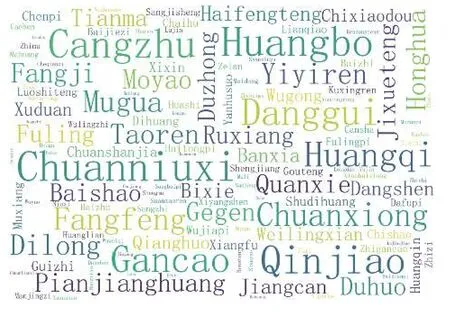
Figure 2 Cloud map of herbs in treating AS by Professor XIONG Jibo
3.1.2 Frequency of prescriptions in treating AS The 103 included TCM cases involved 187 times (45 kinds) of prescriptions,among which five prescriptions have appeared over ten times,as shown in Table 2. The most frequently used prescriptions were Ermiao San (二妙散),which have appeared 31 times,accounting for 16.58% of all prescriptions,followed by Huangqi Chongteng Yin (黄芪虫藤饮),Gegen Jianghuang San (葛根姜黄散),etc.

Table 2 Prescriptions having appeared over 10 times in prescriptions for AS by Professor XIONG Jibo
3.1.3 Properties,flavors,meridian tropism,and efficacy of herbs in treating AS The most frequently reported herbal properties were warm (693 times),followed by flat(448 times),cold (287 times),cool (72 times),and hot (6 times) (Figure 3). The flavors of the herbs were mainly bitter (739 times),pungent (725 times),sweet (630 times),salty (98 times),and sour (84 times) (Figure 4). Herbs mainly accessed to the Liver Meridian of Foot-Jueyin (904 times),Spleen Meridian of Foot-Taiyin (680 times),Lung Meridian of Hand-Taiyin (438 times),Kidney Meridian of Foot-Shaoyin (412 times),Stomach Meridian of Foot Yangming (408 times),and Heart Meridian of Hand-Shaoyin (361 times) (Figure 5). The most frequent herb efficacy was promoting blood circulation and removing blood stasis (292 times),followed by supplementing deficiency (284 times) and dispelling wind and dampness(188 times) (Figure 6). Supplementing deficiency include Qi supplementing,blood supplementing,and Yang supplementing.

Figure 3 Herb properties for AS by Professor XIONG Jibo

Figure 4 Herb flavors for AS by Professor XIONG Jibo

Figure 5 Herb meridian tropisms for AS by Professor XIONG Jibo

Figure 6 Herb efficacy having appeared more than 10 times in prescriptions for AS by Professor XIONG Jibo
3.1.4 Associations among herbs in treating AS In association rule analysis,the herb associations were investigated under the criteria of Support ≥15% and Confidence =100%. A total of 124 association rules were identified.After de-duplication,85 association rules were left,comprising five second-order association rules (Table 3),39 third-order association rules (Table 4),39 fourth-order association rules (Table 5),and two five-order association rules (Table 6). Figure 7 and 8 show the association rules through RStudio.

Table 3 Second-order association rules of herbs in treating AS by Professor XIONG Jibo
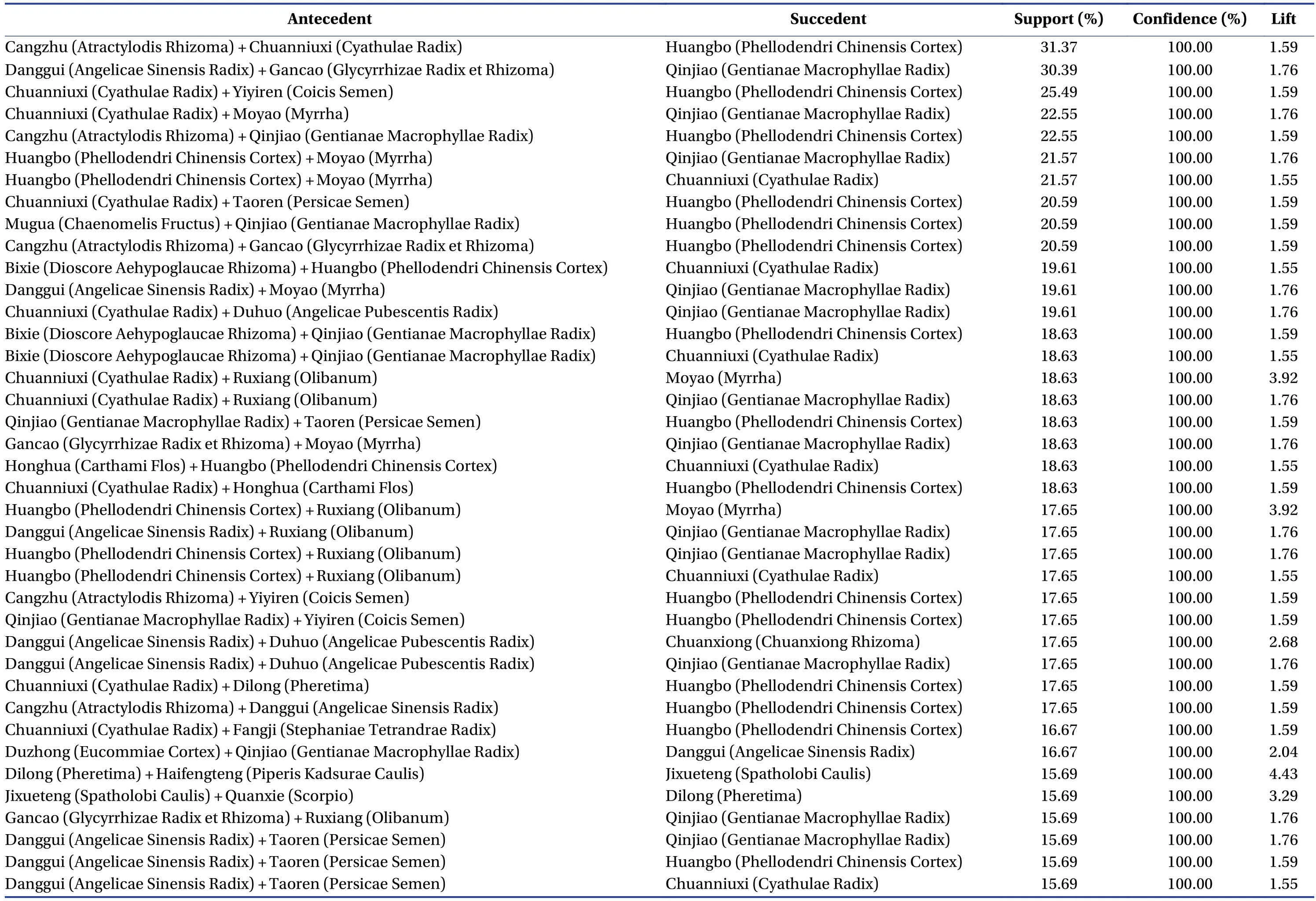
Table 4 Third-order association rules of herbs in treating AS by Professor XIONG Jibo
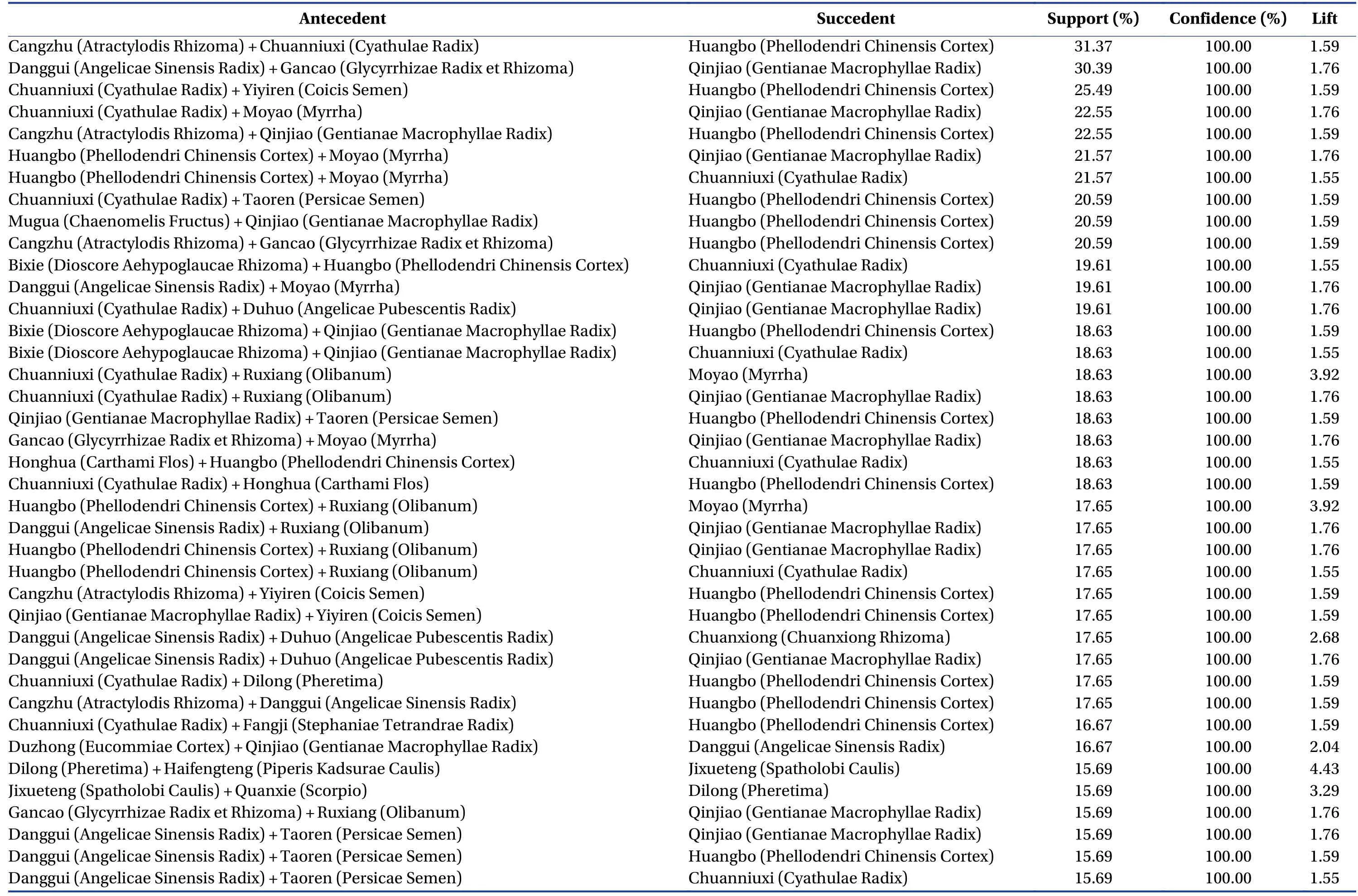
Table 5 Fourth-order association rules of herbs in treating AS by Professor XIONG Jibo

Table 6 Fifth-order association rules of herbs in treating AS by Professor XIONG Jibo

Figure 7 Association rule of herbs in treating AS by Professor XIONG Jibo (graph method)
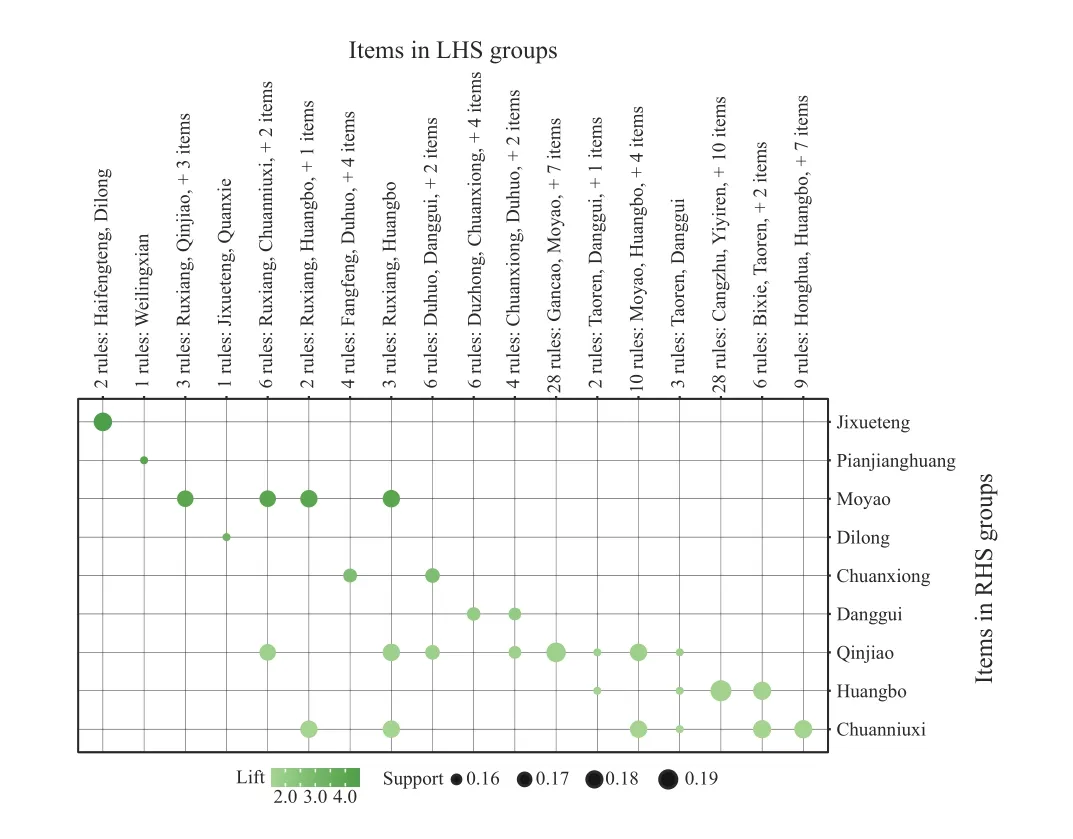
Figure 8 Association rule of herbs in treating AS by Professor XIONG Jibo (grouped matrix method)
3.1.5 Cluster analysis of herbs in treating AS A cluster analysis was performed based on the top 30 herbs,and five clusters were obtained. The details of clusters 1 - 5 are shown in Figure 9. Herbs in cluster 1 (purple) were used to clear heat and dry dampness,activate blood,and dredge pulse. Herbs in cluster 2 (green) were prescribed to replenish Qi,activate blood circulation,dry dampness,and relieve pain. Herbs in cluster 3 (blue) were mainly used to promote blood circulation and remove blood stasis,dry dampness,and relieve pain. Herbs in cluster 4(red) were mainly compressed to strengthen the spleen and stomach,dispel wind,and for dehumidification.Cluster 5 (black) contained herbs for promoting blood circulation,removing blood stasis,and relieving pain.These clusters provide a reference for Professor XIONG Jibo’s medicinal compatibility in the treatment of AS.
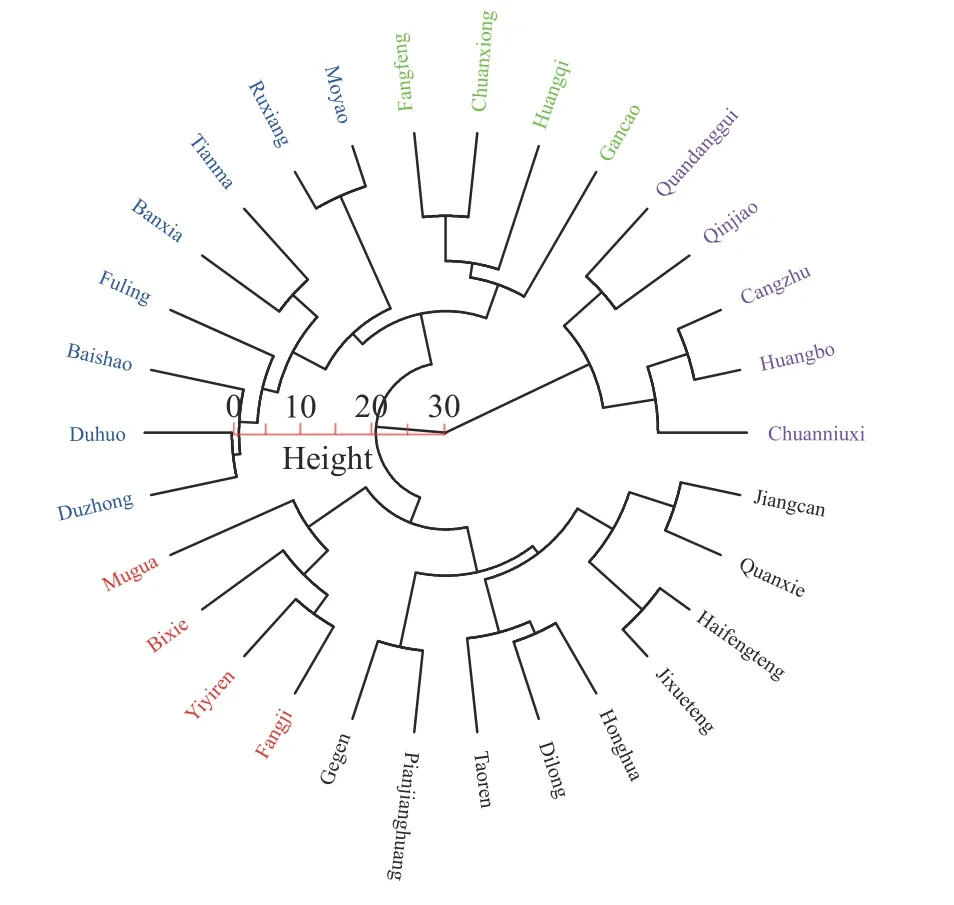
Figure 9 Cluster analysis of top 30 herbs in treating AS by Professor XIONG Jibo
3.2 Prescription patterns of herbs in treating AS by Professor XIONG Jibo
Three main patterns were identified from 187 Chinese prescriptions,among which 54 prescriptions were related to “damp heat pattern”,27 prescriptions were related to “phlegm stasis pattern”,and 18 prescriptions were related to “neck arthralgia pattern”. The 20 herbs most commonly used to treat different patterns are presented in Table 7,and the top 30 association rules are shown in Figure 10 - 12 (Support = 20%,Confidence = 85%).
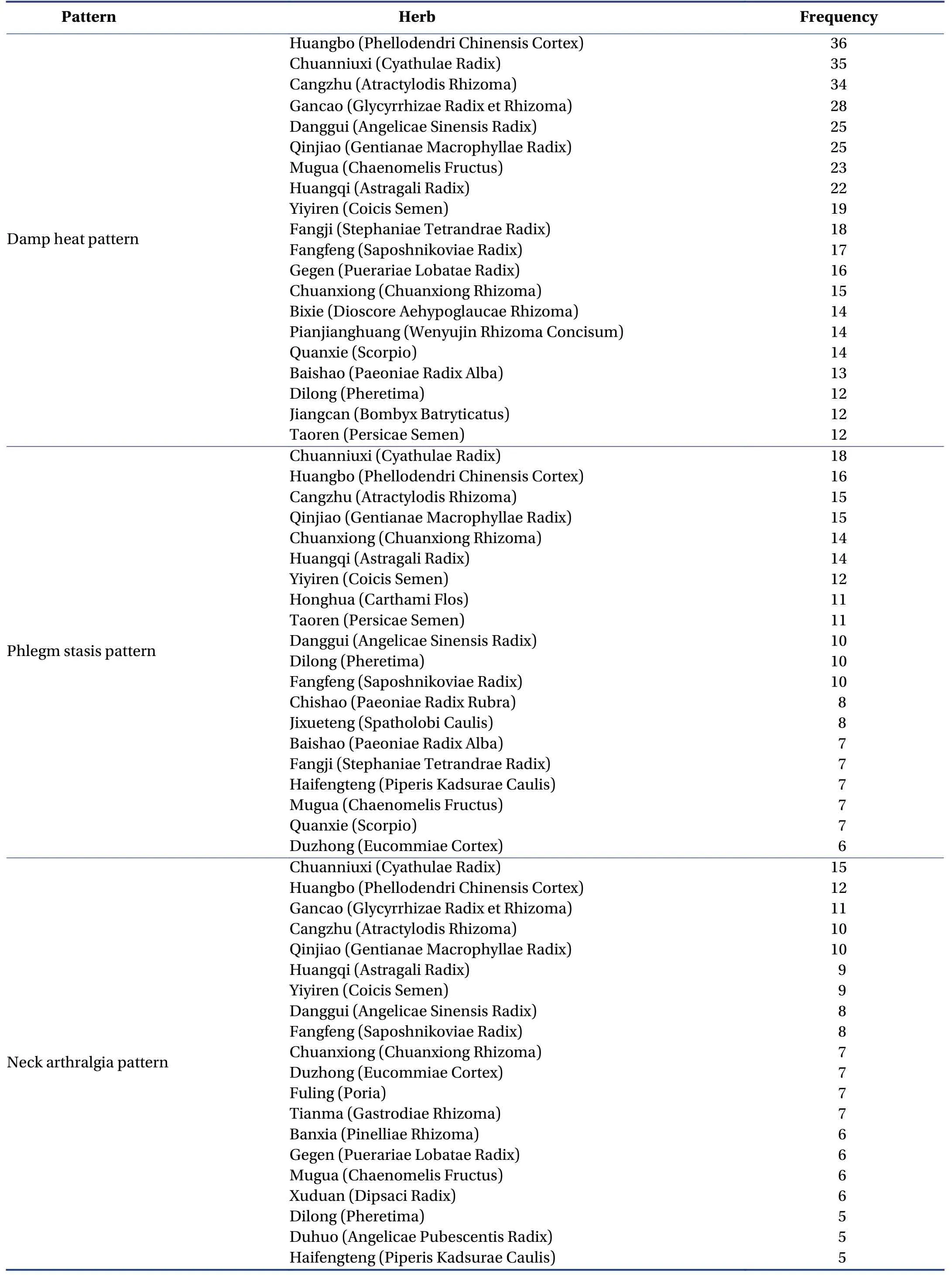
Table 7 Top 20 herbs for different patterns in treating AS by Professor XIONG Jibo
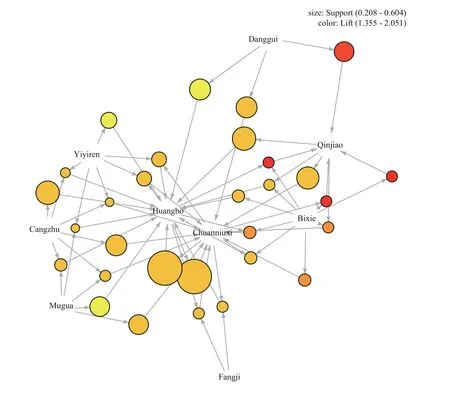
Figure 10 Association rule of damp heat pattern in treating AS by Professor XIONG Jibo
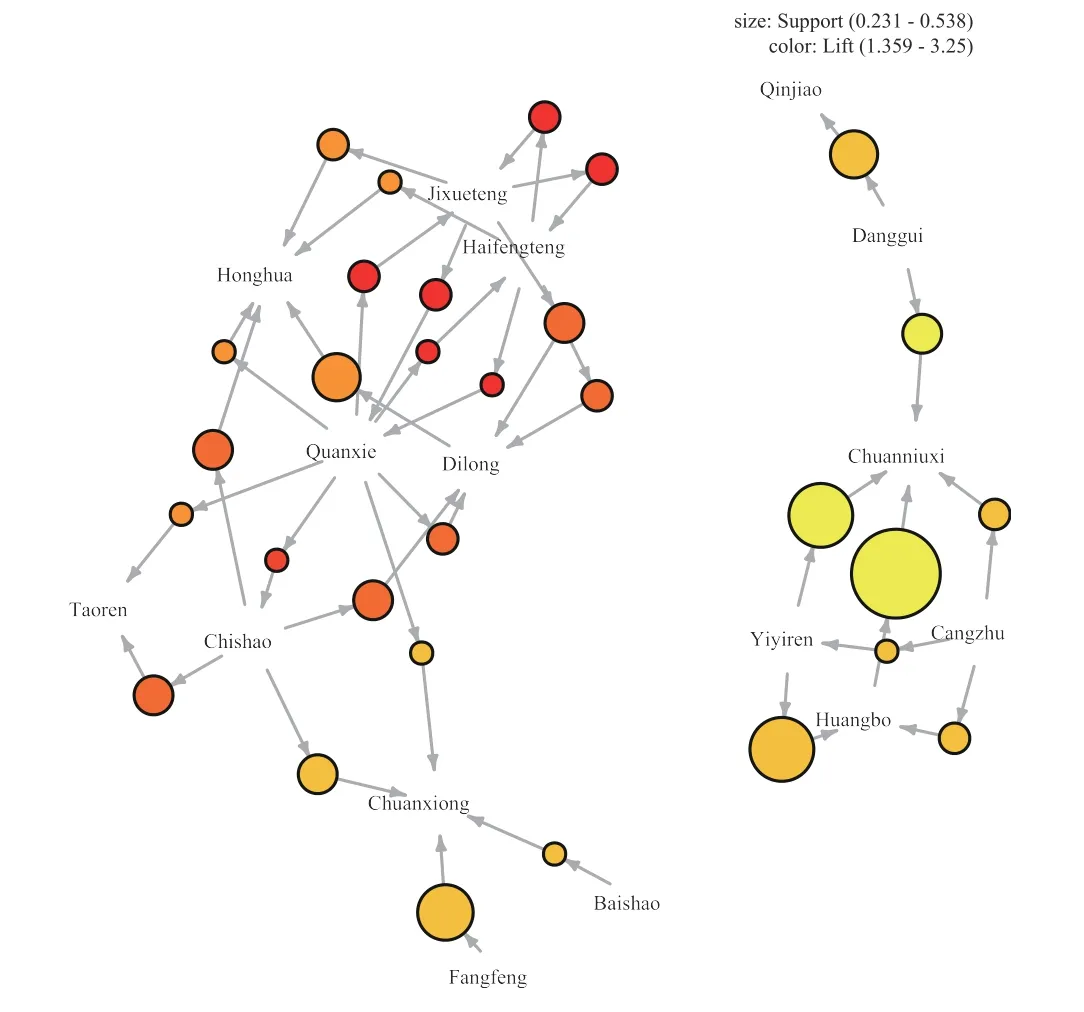
Figure 11 Association rule of phlegm stasis pattern in treating AS by Professor XIONG Jibo
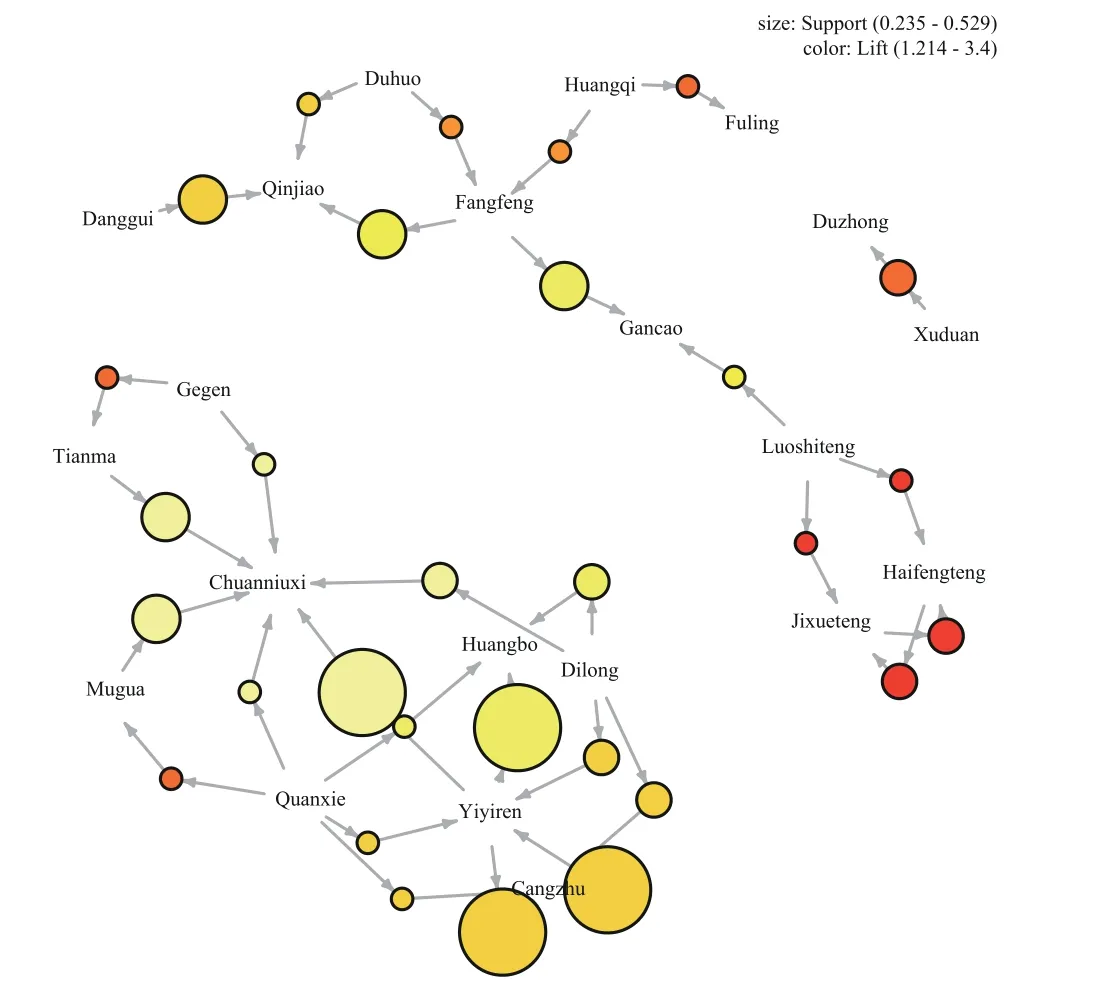
Figure 12 Association rule of neck arthralgia pattern in treating AS by Professor XIONG Jibo
4 Discussion
4.1 Principal therapy of Professor XIONG Jibo for the treatment of AS
In clinical practice,the properties and effects of herbs are based on TCM theories of Yin-Yang and zang-fu,as well as meridian tropism[28]. In this study,10 most commonly used herbs and five most commonly used pairs of herbsboth targeted the liver,spleen,and kidneys,while the herbs used for AS were mainly accessed to the liver,spleen,and kidney meridians. The properties of the herbs were mainly sweet and warm,pungent and warm,and bitter and flat,which were commonly used in warming,clearing,and tonifying methods. Thus,the results showed that the methods of clearing heat and dampness,dredging collaterals and relieving pain,and tonifying Qi and blood were the most commonly used for the treatment of AS. TCM theory explains this discovery from the following three aspects.
First,the spleen is considered to be the source of the production and transformation of Qi and blood[29]. AS with a long disease course leads to deficiency of Qi and blood[30]. TCM attaches importance to strengthening and harmonizing the spleen in the treatment of chronic diseases. The pain experienced by patients with AS is related to nutritional deficiency[31]. Second,the liver governs the tendons and the kidneys govern the bones. If AS lasts for a long time,muscles and bones will be damaged[32].Furthermore,during treatment,attention needs to be paid to nourish the liver and kidneys,as well as strengthening tendons and bones. Third,the spleen is the source of phlegm. Wind,cold,and dampness turn into damp heat arthralgia over time. The pain experienced by patients with AS is related to meridian obstruction,due to the combination of phlegm and blood stasis[33,34]. The treatment of AS requires clearing heat and dampness,removing blood stasis,and relieving pain. Therefore,clearing heat and dampness,dredging collaterals and relieving pain,and supplementing Qi and activating blood circulation are the most commonly used methods for the treatment of AS by Professor XIONG Jibo.
4.2 TCM syndrome differentiation and treatment of AS by Professor XIONG Jibo
Through the visualization of modern computer technology,different modes of high-frequency herbs,herbal pairs,and herbal groups provide a unique view of TCM regarding the etiology,mechanism and treatment of AS.
(i) High-frequency herbs for damp heat pattern generally target the liver and spleen,which further indicate that the spleen is the source of Qi and blood. Dampness can easily get trapped in the spleen and the liver governs the tendons in TCM. Huangbo (Phellodendri Chinensis Cortex) and Chuanniuxi (Cyathulae Radix) can clear dampness heat,dredge collaterals,and relieve pain.Huangbo (Phellodendri Chinensis Cortex) and Cangzhu(Atractylodis Rhizoma) are the components of Ermiao San (二妙散). Ermiao San,recorded in theEffective Formulae Handed Down for Generations(Shi Yi De Xiao Fang,《世医得效方》),clears heat and dries dampness(Figure 10). Ermiao San can inhibit the expression of inducible nitric oxide synthase and reduce the expression of RAW264 induced by lipopolysaccharide 7 nitric oxide production in macrophages[35].
(ii) High-frequency herbs for phlegm-stasis pattern mainly access to the liver and spleen meridians,indicating that the spleen is the source of phlegm. Phlegm and blood stasis are easy to combine,and this could result in obstruction of meridians and collaterals in TCM.Huangqi Chongteng Yin (黄芪虫藤饮) mainly comprises Huangqi (Astragali Radix),Dilong (Pheretima),Quanxie(Scorpio),Jixueteng (Spatholobi Caulis),Haifengteng(Piperis Kadsurae Caulis),and Jiangcan (Bombyx Batryticatus),which are among the top 30 core herbs. The effects of Huangqi Chongteng Yin are replenishing Qi and activating blood circulation,warming meridians,and dredgeing collaterals. Research has shown that Huangqi Chongteng Yin can reduce the joint symptom score of collagen induced arthritis (CIA) rats by inhibiting the increase in serum erythrocyte sedimentation rate (ESR)and rheumatoid factor (RF),and have good anti-inflammatory and immunomodulatory effects on CIA rats[36].Herb groups for phlegm stasis pattern also support these findings (Figure 11).
(iii) Herbs for treating neck arthralgia pattern mainly comprise Gegen Jianghuang San (葛根姜黄散) for promoting blood circulation and removing blood stasis. Gegen Jianghuang San consists of Gegen (Puerariae Lobatae Radix),Pianjianghuang (Wenyujin Rhizoma Concisum),and Weilingxian (Clematidis Radix et Rhizoma),a commonly used prescription for the treatment of cervical arthralgia (cervical spondylosis,shoulder neck syndrome,and pillow),and its effects are relieving muscle and superficial pain,promoting blood circulation,and removing arthralgia (Figure 12)[37].
(iv) Herbs used for clearing heat and dampness and promoting blood circulation are the high-frequency herbs in the three patterns,which further support the method used for clearing heat and dampness,relieving collaterals,and relieving pain in the treatment of AS by Professorr XIONG Jibo. Combined Professor XIONG Jibo’s viewpoint on the treatment of AS and results of our study,we have described syndrome differentiation and the corresponding treatment of AS by Professor XIONG Jibo,as shown in Figure 13.

Figure 13 AS medication experience model of Professor XIONG Jibo
5 Conclusion
Our study showed that Professor XIONG Jibo’s principle for treating AS is applying clearing heat and dampness,relieving collaterals and pain,and invigorating Qi and blood. The damp heat,phlegm stasis,and neck arthralgia patterns were the most common syndromes in treating AS by Professor XIONG Jibo. In this study,30 of the most frequently used herbs were identified. Furthermore,125 herbs generally accessed to the liver,spleen,heart,stomach,lung,and kidney meridians. The strengths of this study: (i) visualization is helpful to show the diagnosis and treatment experience of TCM Master;(ii) the established model can be used for data mining for a large number of cases. The limitations of this study: the sample size of cases needs to be further supplemented.Huangbo (Phellodendri Chinensis Cortex) + Chuanniuxi(Cyathulae Radix),Qinjiao (Gentianae Macrophyllae Radix) + Chuanniuxi (Cyathulae Radix),Danggui (Angelicae Sinensis Radix) + Qinjiao (Gentianae Macrophyllae Radix) were the three most frequently used herb pairs.The core prescriptions used for treating AS by Professor XIONG Jibo were Ermiao San,Huangqi Chongteng Yin,and Gegen Jianghuang San. The herbs of core prescription included Cangzhu (Atractylodis Rhizoma),Chuanniuxi(Cyathulae Radix),Gancao (Glycyrrhizae Radix et Rhizoma),Huangbo (Phellodendri Chinensis Cortex),Mugua (Chaenomelis Fructus),Qinjiao (Gentianae Macrophyllae Radix),Danggui (Angelicae Sinensis Radix),and Yiyiren (Coicis Semen). This study provided a basis for the intellectualization of Professor XIONG Jibo's experience in treating AS.
Fundings
Project of State Administration of Traditional Chinese Medicine (GZY-YZS-2019-45),The Horizontal Project of Hunan Medical College (HYH-2021Y-KJ-6-33),Scientific Research Project of Hunan Provincial Department of Education in 2021 (21C0223),and Natural Science Foundation of Hunan Province in 2022 (1524).
Competing interests
The authors declare no conflict of interest.
 Digital Chinese Medicine2022年2期
Digital Chinese Medicine2022年2期
- Digital Chinese Medicine的其它文章
- Instructions for Authors
- Protective effects of Zuogui Jiangtang Jieyu Formula on hippocampal neurons in rats of diabetes complicated with depression via the TRP/KYN metabolic pathway
- Immunomodulatory effect of pachymaran on cyclosporine A (CsA)-induced lung injury in mice
- Preventive and therapeutic effects of Aerva lanata (L.) extract on ethylene glycolinduced nephrolithiasis in male Wistar albino rats
- Extraction process in Chuantieling (CTL) based on the quality by design (QbD)concept
- Mechanisms of Dihuang (Rehmanniae Radix) in treating diabetic nephropathy complicated with depression based on network pharmacology
